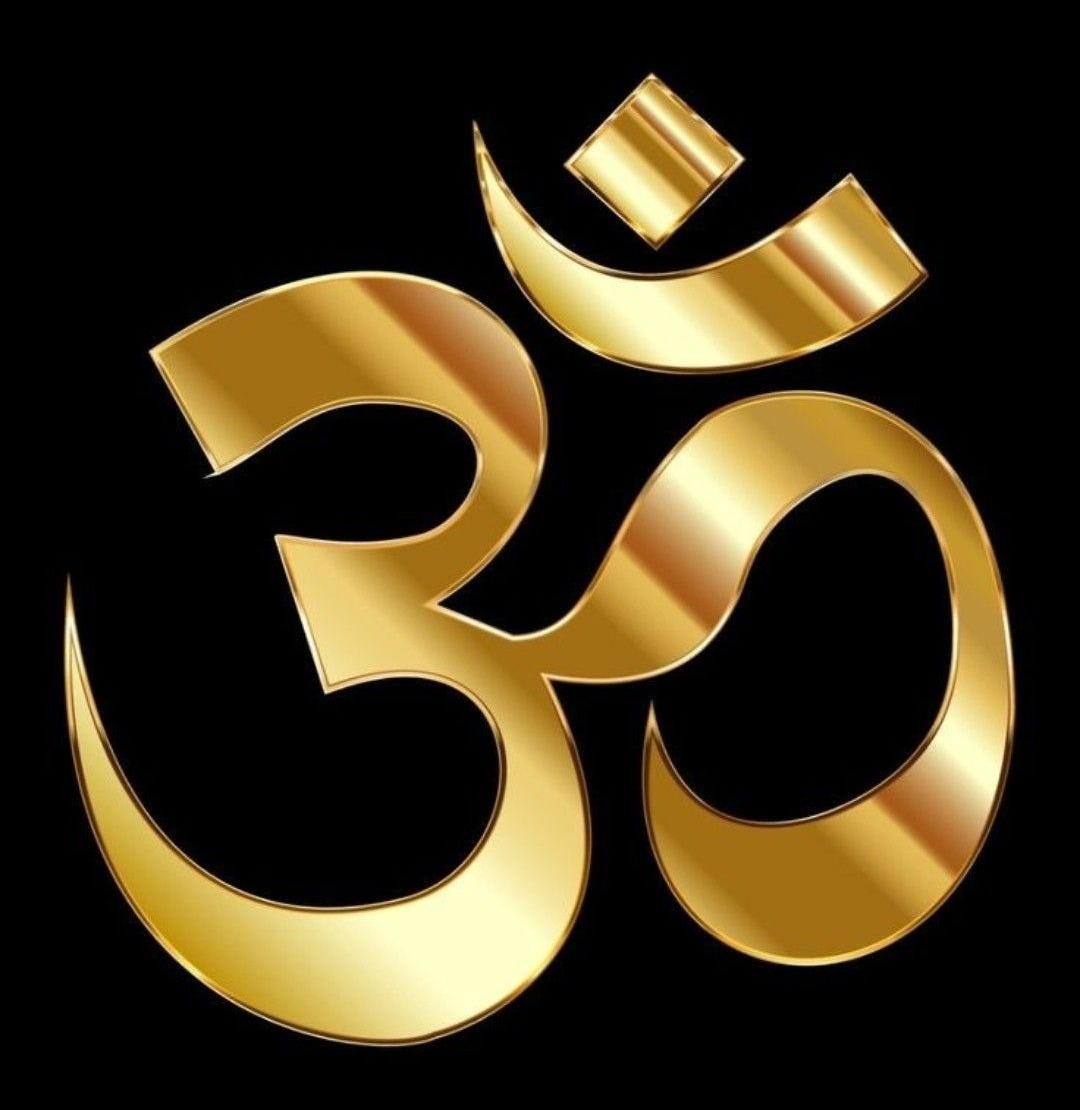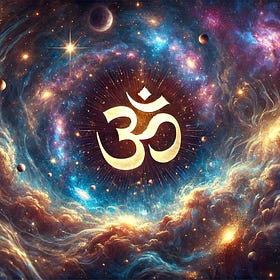Understanding the Supreme Syllable Oṁ
The Vedas give great importance to the syllable Oṁ, which is considered the sound representation of the Lord. All the Vedic mantras start with Oṁ, and this is actually what gives them value.
The Vedas give great importance to the syllable Oṁ, which is considered the sound representation of the Lord. All the Vedic mantras start with Oṁ, and this is actually what gives them value. As Prabhupada mentions, “the Vedic mantras or hymns have transcendental value because they are prefixed by the syllable Oṁ” (TLC 20).
The syllable Oṁ is so important that it has even His own symbol in the Devanagari alphabet, ॐ. By the way, Srila Prabhupada insists on referring to Oṁ as “He”, not only using the personal pronoun, but with an uppercase H, indicating that we are not speaking about ordinary sound, but a direct incarnation of the Supreme. Just as Krsna comes as Lord Narasimha, Varāha, etc., He also appears in this world in the form of the sacred syllable Oṁ.
Being the sound incarnation of the Lord, Omkāra is just like a deity of the Lord. Just like we perform ceremonies in front of the deity, or in the presence of the fire (in a fire ceremony), the same functions can be performed by just pronouncing the Omkāra. In Srimad Bhagavatam (9.20.16), for example, it is described how Mahārāja Duṣmanta married Śakuntalā in the forest by just pronouncing the Omkāra. It’s described that this process is also practiced by the Gandharvas in the celestial planets. By pronouncing the Omkāra, one invokes the Supreme Lord to sanctify the marriage, just like when one performs a fire sacrifice.
Although transliterated as “Oṁ”, with just two letters, the sacred syllable ॐ is actually composed of three sounds, “a”, “u”, and “m”. These three sounds have special significance. The first, “a” represents the Supreme Personality of Godhead in His personal aspect, as Krsna or Viṣnu. Different transcendentalists will vibrate the sound meditating in the Supreme according to their level of understanding (yogis will take the Supreme as being the localized Paramātmā, while impersonalists will take it as meaning the impersonal brahman), but it’s important to understand that in the highest aspect, the first of the three sounds addresses the Supreme in His personal aspect. The second sound, “u”, addresses the internal potency of the Lord, which in the highest understanding is personified in the form of Śrīmat Rādhārāṇī. Krsna is never alone; therefore, by “au” we address Krsna and His potency together. Finally, “m” means the living entity, the soul, in his original form as the eternal servitor of the Lord. The highest meaning of the three sounds is to surrender to the Lord in His personal aspect, declaring oneself as an eternal servitor of the Lord. In other words, by pronouncing the Omkāra, a transcendentalist recovers his original, lost position as an eternal associate of the Lord.
This higher understanding of the Omkāra is explained by Srila Prabhupada (TLC 20): “The Vaiṣṇavas interpret Oṁ-kāra, a combination of the letters a, u and m, as follows: The letter a indicates Kṛṣṇa, the Supreme Personality of Godhead, the letter u indicates Śrīmatī Rādhārāṇī, Kṛṣṇa’s eternal consort, and the letter m indicates the living entity, the eternal servitor of the Supreme Lord.”
In this way, the Omkāra is non-different from the mantra Hare Krsna. The meaning and the result of both mantras are the same, as Srila Prabhupada explains in the same purport: “The sound representation or name of the Supreme Lord is as good as the Supreme Lord Himself. By vibrating such sounds as Oṁ-kāra or Hare Kṛṣṇa, Hare Kṛṣṇa, Kṛṣṇa Kṛṣṇa, Hare Hare/ Hare Rāma, Hare Rāma, Rāma Rāma, Hare Hare, one can be delivered from the contamination of this material world. Because such vibrations of transcendental sound can deliver a conditioned soul, they are known as tāraka-mantras.” The main difference is that the Omkāra is a Vedic mantra that can be chanted only by people who are dully initiated in the Vedic tradition, while the Mahā-Mantra Hare Krsna can be chanted by anyone by the mercy of Sri Caitanya Mahāprabhu. In this way, the chanting of Hare Krsna replaced the chanting of the Omkāra in the age we live in, although both mantras were originally equally powerful.
The Nārada Pancaratra says that “When the transcendental sound is vibrated by a conditioned soul, the Supreme Lord is present on his tongue.” and the Māṇḍūkya Upaniṣad confirms that when the Omkāra is chanted, one attains perfect spiritual vision.
Mayavadis don’t accept the Omkāra as a sound representation of the Supreme, classifying it instead as just a material symbol. This comes all the way from Śrīpāda Śaṅkarācārya, who replaced the Omkāra with the mantra “tat tvam asi” as the main mantra in his sect. Sankara explains about the supreme ātma, the impersonal Brahman, and then quotes the mantra “tat tvam asi” from the Chāndogya Upaniṣad (6.8.7). Tat tvam asi can be translated as “you are that”, which in Sankara’s imaginary explanation indicates our identity as part of the Supreme Brahman. Mayavadi gurus in the West frequently translate it as “I’m god”, and teach their disciples to repeat this “mantra” as a means of self-realization. That was the mantra a popular guru was selling to his followers in the 1970s.
As Prabhupada mentions: “ The principal word in the Vedas – praṇava, or Oṁ-kāra – is the sound representation of the Supreme Lord. Therefore Oṁ-kāra should be considered the supreme sound. But Śaṅkarācārya has falsely preached that the phrase tat tvam asi is the supreme vibration. Oṁ-kāra is the reservoir of all the energies of the Supreme Lord. Śaṅkara is wrong in maintaining that tat tvam asi is the supreme vibration of the Vedas, for tat tvam asi is only a secondary vibration.”
We know that Śrīpāda Śaṅkarācārya was an incarnation of Lord Śiva, but he received the mission of teaching Māyāvāda philosophy in order to cheat the Buddhists in India, bringing them back to the study of the Vedas, paving thus the way for Vaishnava ācāryas like Madhvācārya, Rāmānujācārya, etc. to gradually reestablish the proper conclusion of the Vedas, which at the time had been completely lost. However, because the Mayavadis are offenders, Śaṅkarācārya didn’t tell them to chant the Omkāra or any other holy names, giving them instead an imaginary mantra.
Vaiṣnavas, however, properly understand the meaning and the potency of the Omkāra, and we continuously chant Him in the form of the Mahā-Mantra Hare Krsna.
You can also donate using Buy Me a Coffee, PayPal, Wise, Revolut, or bank transfers. There is a separate page with all the links. This helps me enormously to have time to write instead of doing other things to make a living. Thanks!
Read also:
The meaning of "Om Tat Sat"
The words "Om Tat Sat" are very important in Vedic literature. In short, Om tat sat means "Absolute Truth is Eternal". However, just like other Vedic mantras, it has a very deep meaning.




Thank you for the next level information.